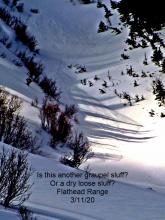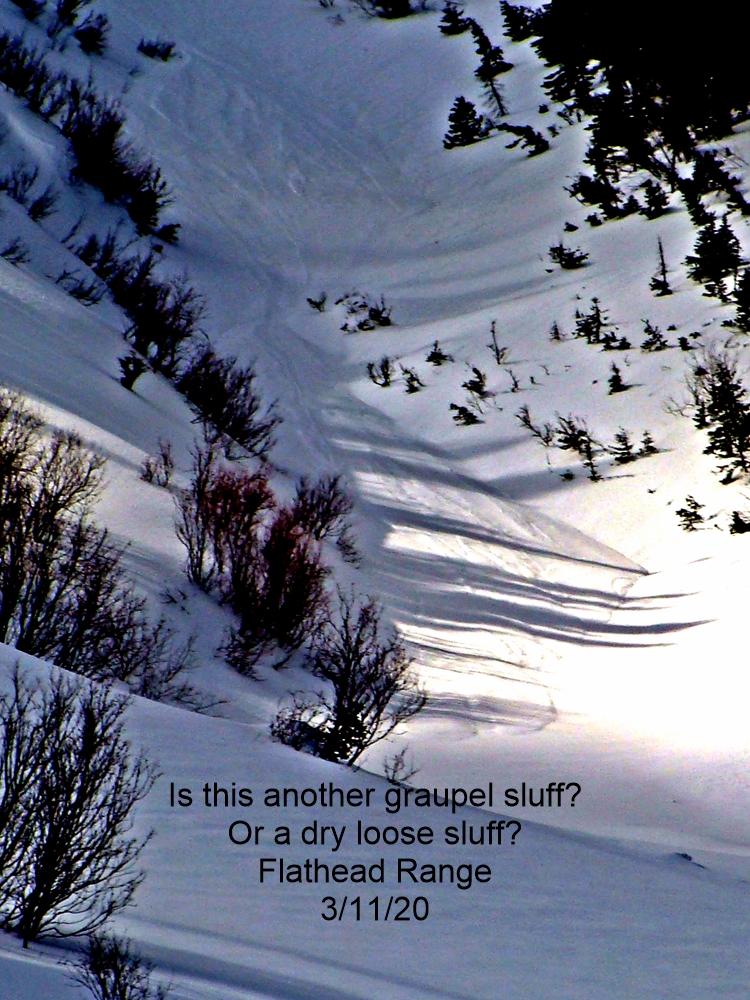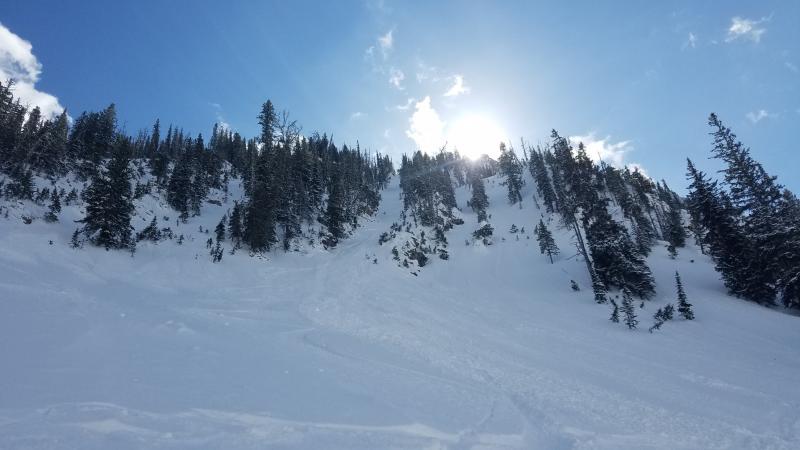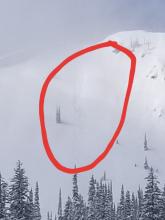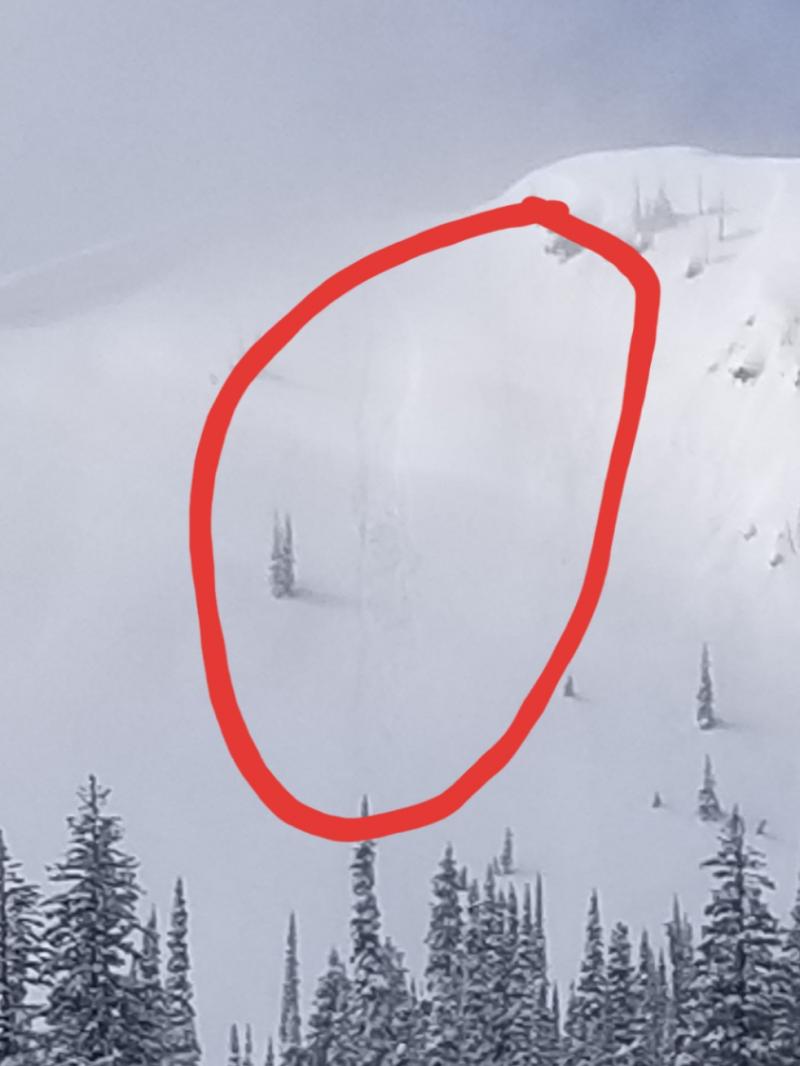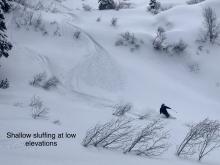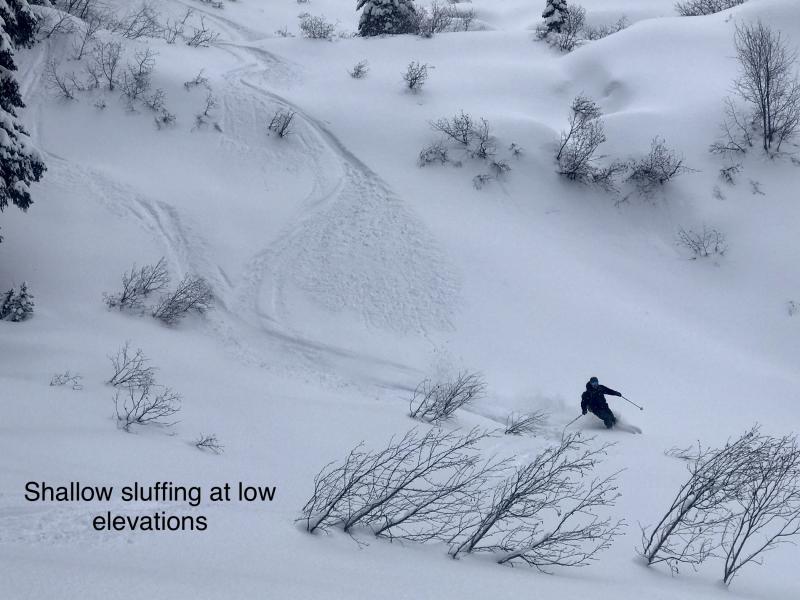| Sunday | Sunday Night | Monday | |
|---|---|---|---|
| Cloud Cover: | Partly/mostly cloudy. | Partly/mostly cloudy. | Warming. |
| Temperatures: | 20-30 deg. F. | 2-18 deg. F. | 24-36 deg. F. |
| Wind Direction: | S | S-E | SW-SE |
| Wind Speed: | 5-6 gusts 17-18 | 4-5 | 4-5 |
| Snowfall: | 0 in. | 0 in. | 0 in. |
| Snow Line: |
Whitefish Range
Swan Range
Flathead Range and Glacier National Park
How to read the forecast
Variable winds over the past few days transported recent snow and created windslabs on multiple aspects. The avalanche danger is MODERATE above 5000 feet and human triggered avalanches are possible. Carefully evaluate the snowpack before committing to a slope, particularly in recently wind loaded terrain. The danger is LOW below 5000 feet.

2. Moderate
?
Above 6500 ft.
2. Moderate
?
5000-6500 ft.
1. Low
?
3500-5000 ft.
- 1. Low
- 2. Moderate
- 3. Considerable
- 4. High
- 5. Extreme
-
Type ?
-
Aspect/Elevation ?
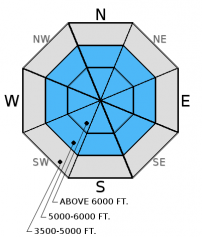
-
Likelihood ?CertainVery LikelyLikelyPossible
 Unlikely
Unlikely -
Size ?HistoricVery LargeLargeSmall

The most recent series of storms that moved through the area came in with surprisingly light wind leaving behind an abundance of low density, cohesionless snow that is easily drifted to leeward slopes. Over the past few days winds have blown out of just about every direction and formed slabs on multiple aspects. Some of the wind slabs you will encounter are old and enough time has elapsed for them to settle and strengthen, others are forming as you read this and will be sensitive to human triggers today. It would be wise to treat all wind loaded areas as suspect and carefully evaluate this terrain before skiing or riding in it. Look for smooth, rounded features on the slope or deeper deposition areas around features like tree islands or rocks. Remember, that even a small avalanche can have severe consequences if you trigger it in or around terrain traps.
-
Type ?
-
Aspect/Elevation ?

-
Likelihood ?CertainVery LikelyLikelyPossible
 Unlikely
Unlikely -
Size ?HistoricVery LargeLargeSmall

The loose, dry avalanche problem should be diminishing today with continued settlement and consolidation of surface snow, particularly where the sun baked the snow and refroze overnight. On steep, shaded slopes and at mid elevation where the temperature will approach or even rise above freezing and moisten the surface snow the potential exists to trigger small, loose avalanches. Remember, these are most dangerous when combined with terrain traps such as rocks, trees, cliffs, or a gully.
Changing Conditions and Changing Mindset: This last storm delivered low density snow that made for deep, excellent riding and skiing with pretty stable conditions. However, warming temps creeping near and above the freezing mark will create a more cohesive surface slab. This slab could become more susceptible to triggering. We currently don't have any major weak layers within the top part of the snowpack, but we could begin to see slab development on density changes in the upper part of the snowpack. Pay attention to changing conditions today and how the snow feels under your skis or sled. If it feels like the surface snow is becoming more "slabby" then reassess terrain choices.
There are currently two deeper layers in the snowpack that still pose concern, particularly in areas with a shallow snowpack. We haven't observed or received reports of avalanches on these layers (even during or after last week's storms) or reactiveness in stability tests, but they are easily identifiable and worthy of investigation in your snowpit due to their variablity.
1. In some locations throughout the advisory area we noted and have received observations of weak, sugary snow (facets) near the ground. This layer has not been reactive in stability tests in over three weeks, but in shallow areas (snowpack less than 3-4 feet deep) this layer may be more developed and could be more reactive. It is best to avoid areas of shallow snowpack where this layer exists (like steep, rocky slopes).
2. The December 9 rain crust still lurks throughout most of the advisory area. A layer of softer facets (weak, sugary snow) below the crust has shown no signs of instability (fracture or propagation) in our snowpits for two weeks, but it's still there. It is unlikely you'll trigger an avalanche on this layer, but not impossible. It is still worth taking the time to dig into the snow and see how it is reacting in the areas that you are skiing or riding.
Yesterday, Erich was on Nyack Peak in the Flathead Range and witnessed a natural, wind slab avalanche on a steep, north facing slope as well as another recent avalanche. He also noted wind drifting the snow onto north and east aspects above 5500 feet (observation).
Mark and I were in the Swan Range on the Mt Aeneas ridge where moderate east wind was transporting the recent snow along the high ridgelines (photo). Late in the afternoon the sun caused the surface snow to become moist and we observed several small, loose snow avalanches as a result (photo). Early in the day we noted a thin, surface crust on sunny aspects that was formed the previous day.
Snowboarders in the Wahoo Creek drainage in the Flathead Range found recent wind slabs that were reactive in stability tests and wind drifting occurring at the upper elevations (observation). Also in Flathead Range, skiers near Stanton Lake found a shallow snowpack with weak snow near the ground that was reactive in stability tests (observation).
Friday, skiers on Mt. Adams in the Essex Creek area of the Flathead Range noted thin, reactive slabs in the area and a thin crust near the surface on sunny slopes (Observation).
Thursday, Erich traveled to the Essex Creek and Marion Lake drainages in the Middle Fork of the Flathead Range (observation). They observed active wind transport near ridgelines (photo) and natural loose sluffs (photo) on steep slopes.
Mark toured with BNSF avalanche safety on Thursday in southern Glacier NP and observed wind transport with shallow wind slabs developing. He also reported shooting cracks within the new wind slab (photo and observation).
Skiers just south of Marias Pass also reported sensitive wind slabs (observation). Skiers in the Apgar Range Thursday also observed wind loading near ridgetops (observation), but no other obvious signs of instability.
Thanks to everyone for submitting observations. They are extremely useful for everyone.
Visit our Observations page and our You Tube channel for more observations from the entire season.
Please let us know what you are seeing out there. Your observations are important and valued.
HOW TO SUBMIT OBSERVATIONS:
Email: [email protected]
Call and leave a message: 406.387.3821
You can also submit quick observations via text: 406.241.4571 (FAC mobile)
OR
Submit Snowpack Observations: http://www.flatheadavalanche.org/node/add/snowobs
Submit Avalanche Observations: http://www.flatheadavalanche.org/node/add/avyobs
Yesterday was another beautiful, sunny day above the clouds in the valley. Winds gusted to 25 mph on the high ridges out of the northeast and east and temperatures approached the freezing mark, but remained just below. Currently, temperatures above 6000 feet range from 10º-21º F. Winds shifted and are out of the south and southwest at 5-15 mph with gusts from 13-19 mph. Today, expect clouds to move into the area with temperatures remaining in the upper 20s to low 30s. Winds will continue out of the south and southwest at 5-15 mph with gusts in the mid 20s along ridgelines.
| 0600 temperature: | 13-21 deg. F. |
| Max. temperature in the last 24 hours: | 26-31 deg. F. |
| Average wind direction during the last 24 hours: | NE-E |
| Average wind speed during the last 24 hours: | 10-20 mph |
| Maximum wind gust in the last 24 hours: | 24-27 mph |
| New snowfall in the last 24 hours: | 0 inches |
| Total snow depth: | 47-60 inches |
This advisory applies only to backcountry areas outside established ski area boundaries. This advisory describes general avalanche conditions and local variations always occur. This advisory expires at midnight on the posted day unless otherwise noted. The information in this advisory is provided by the USDA Forest Service who is solely responsible for its content.














